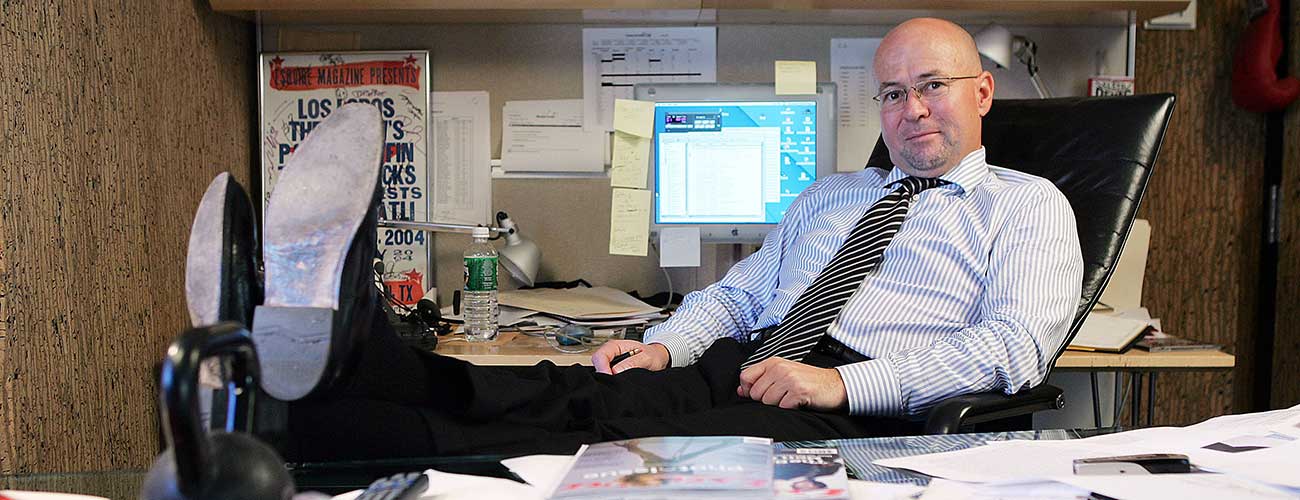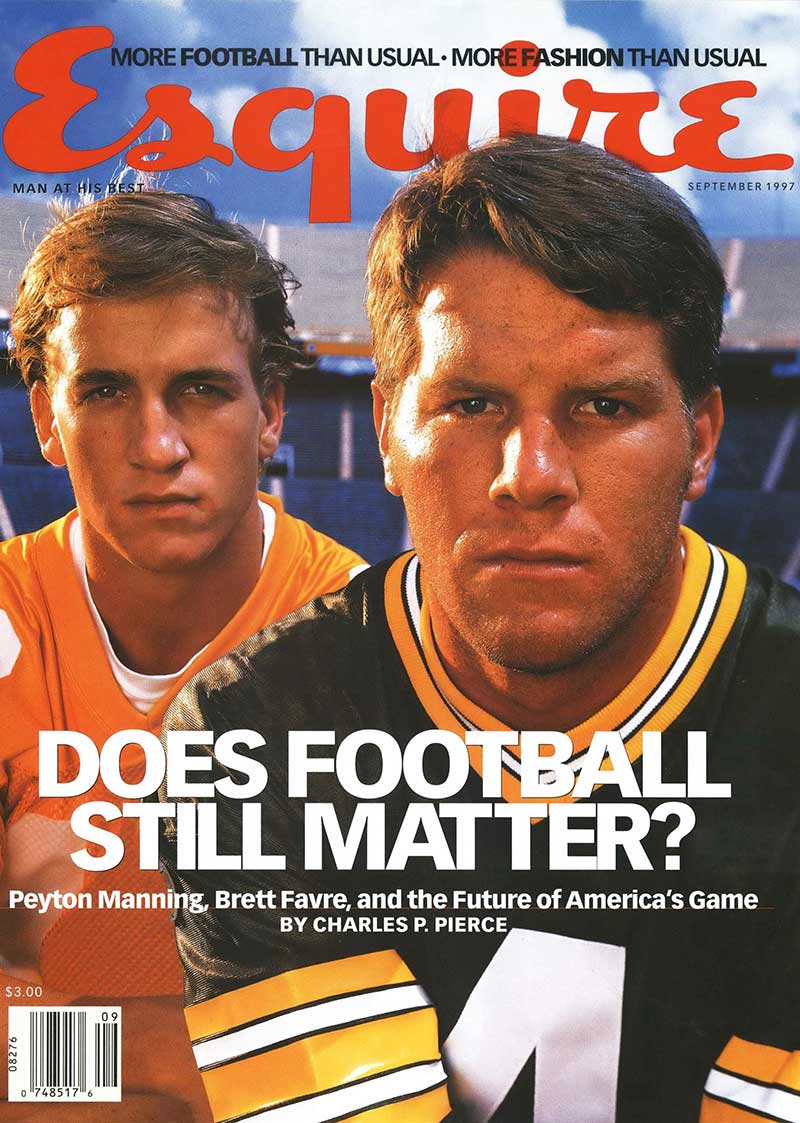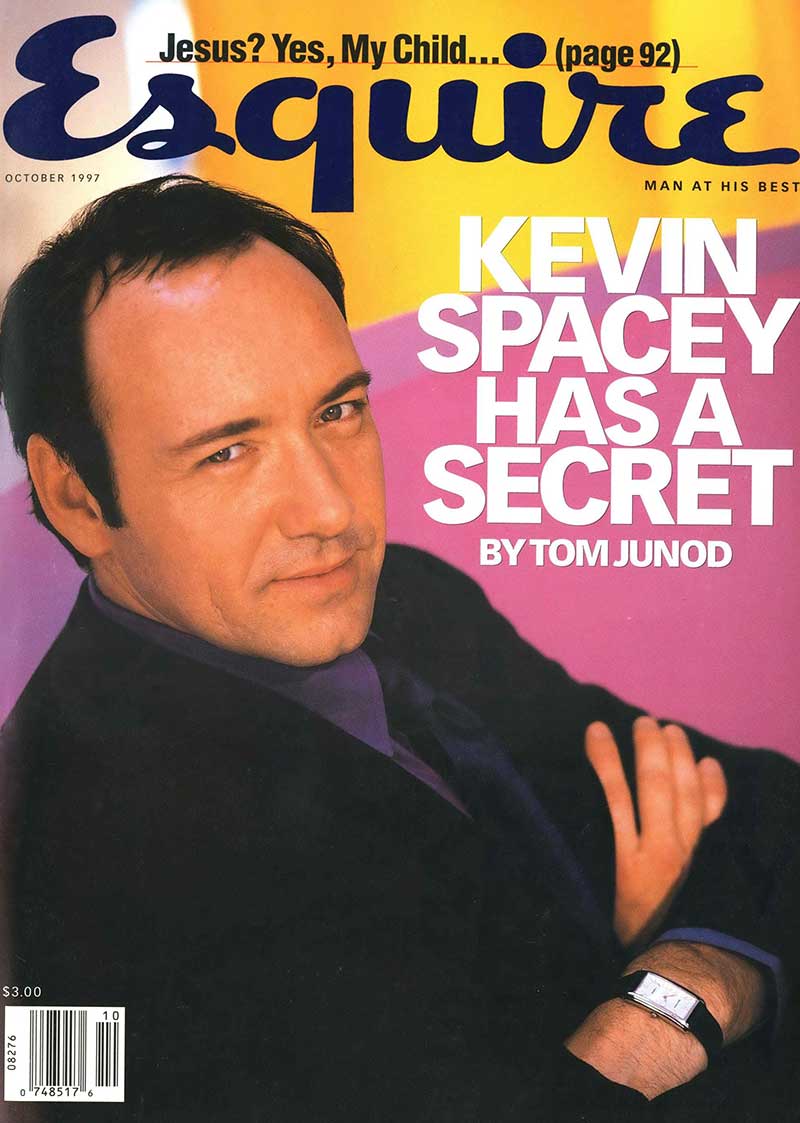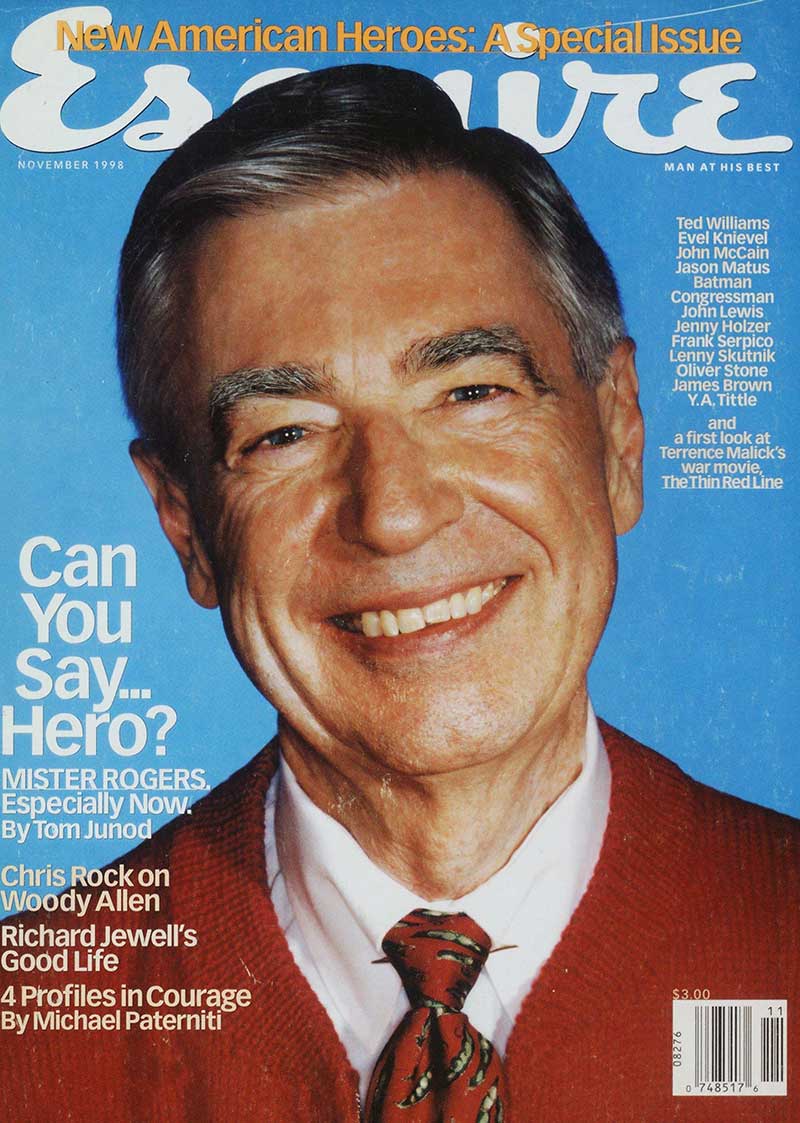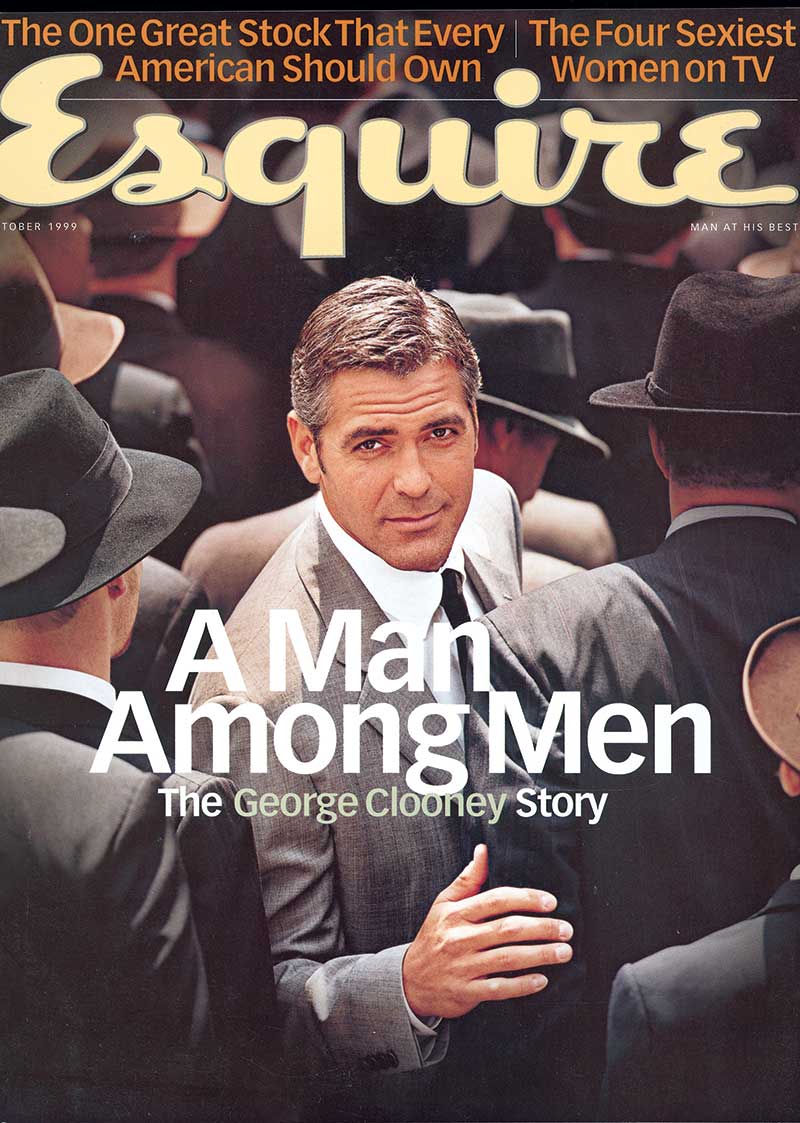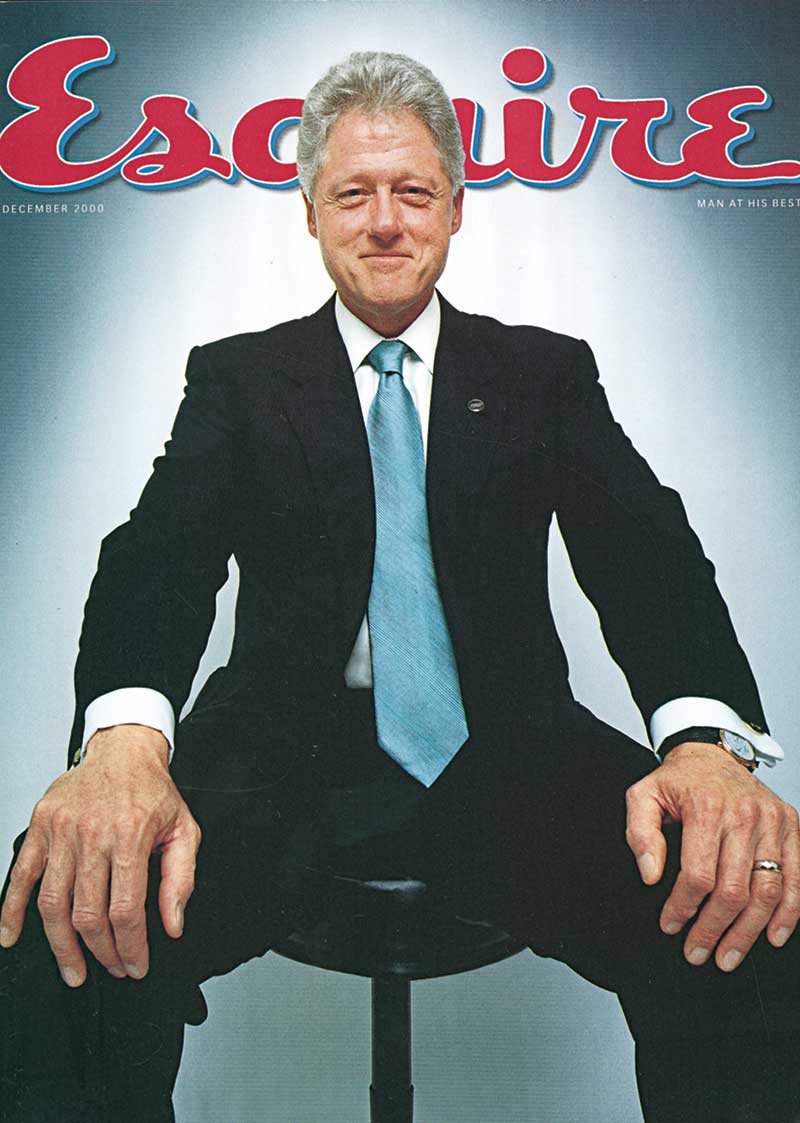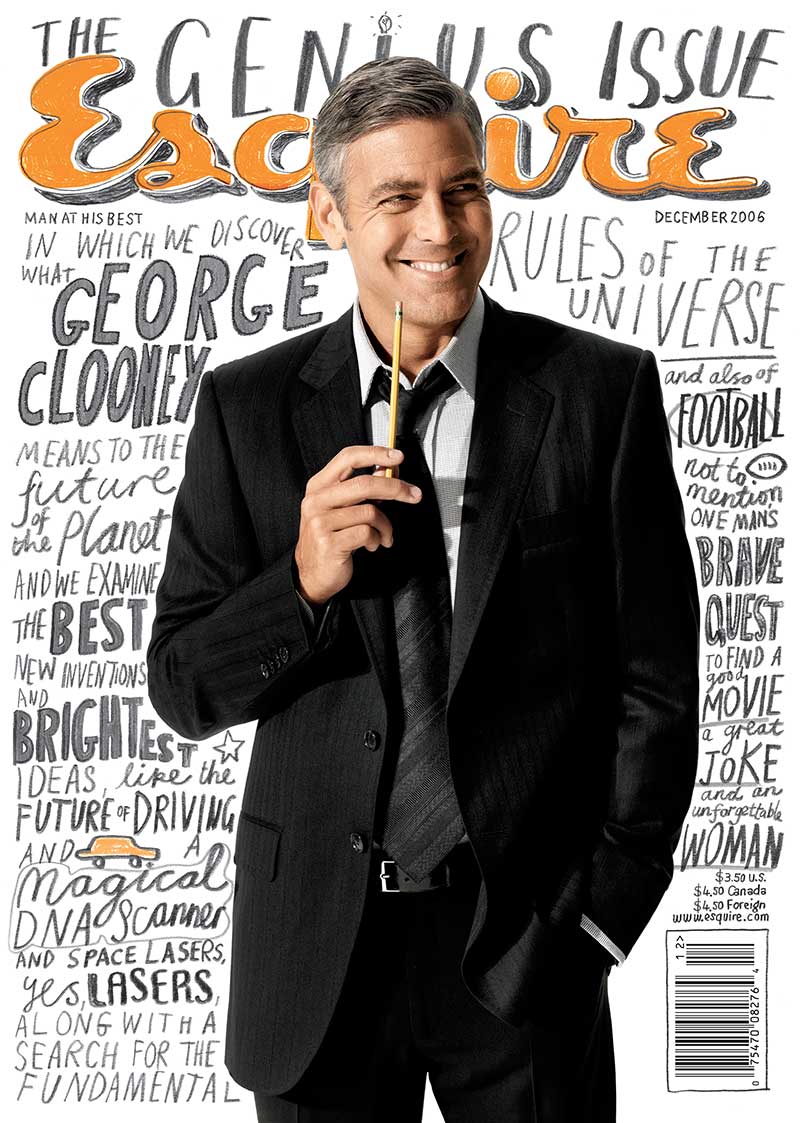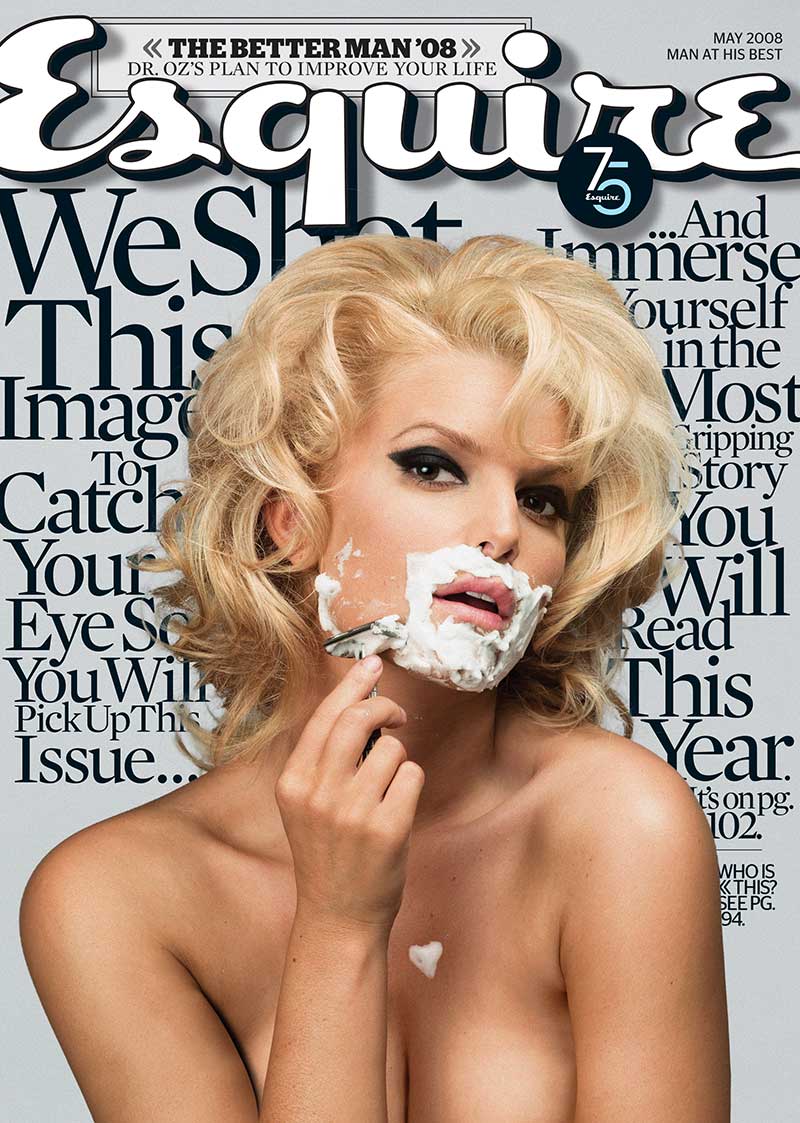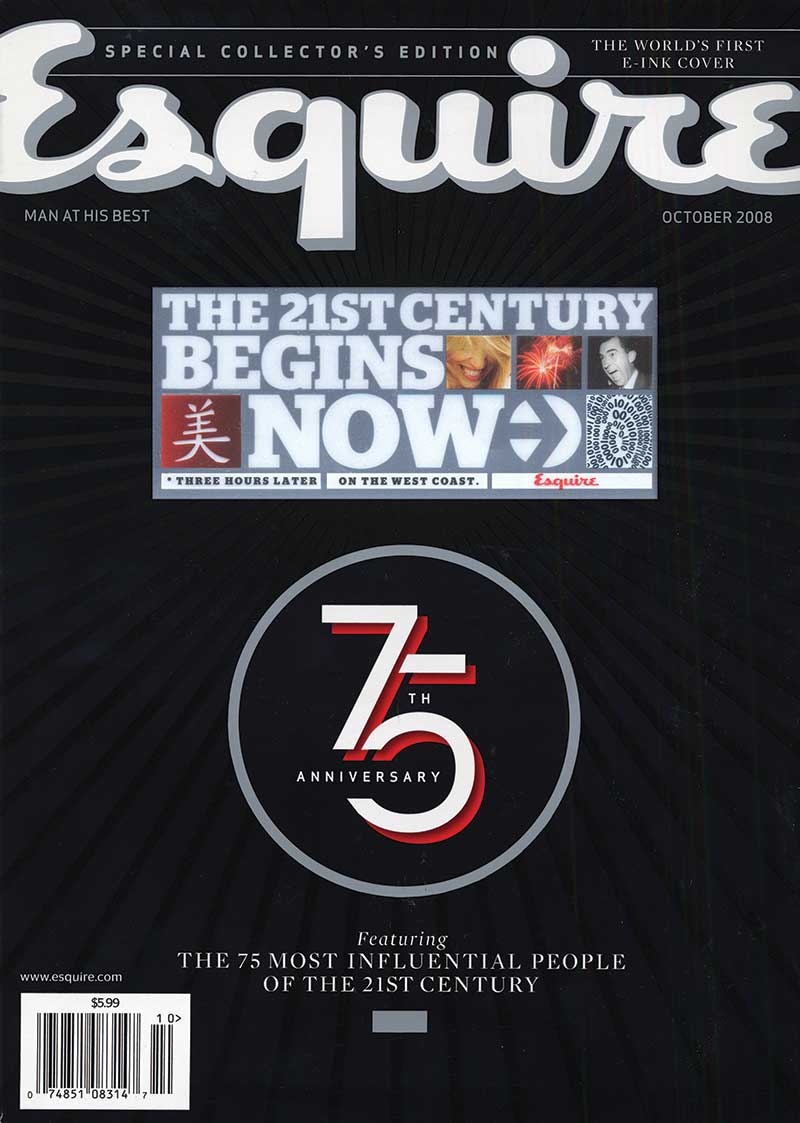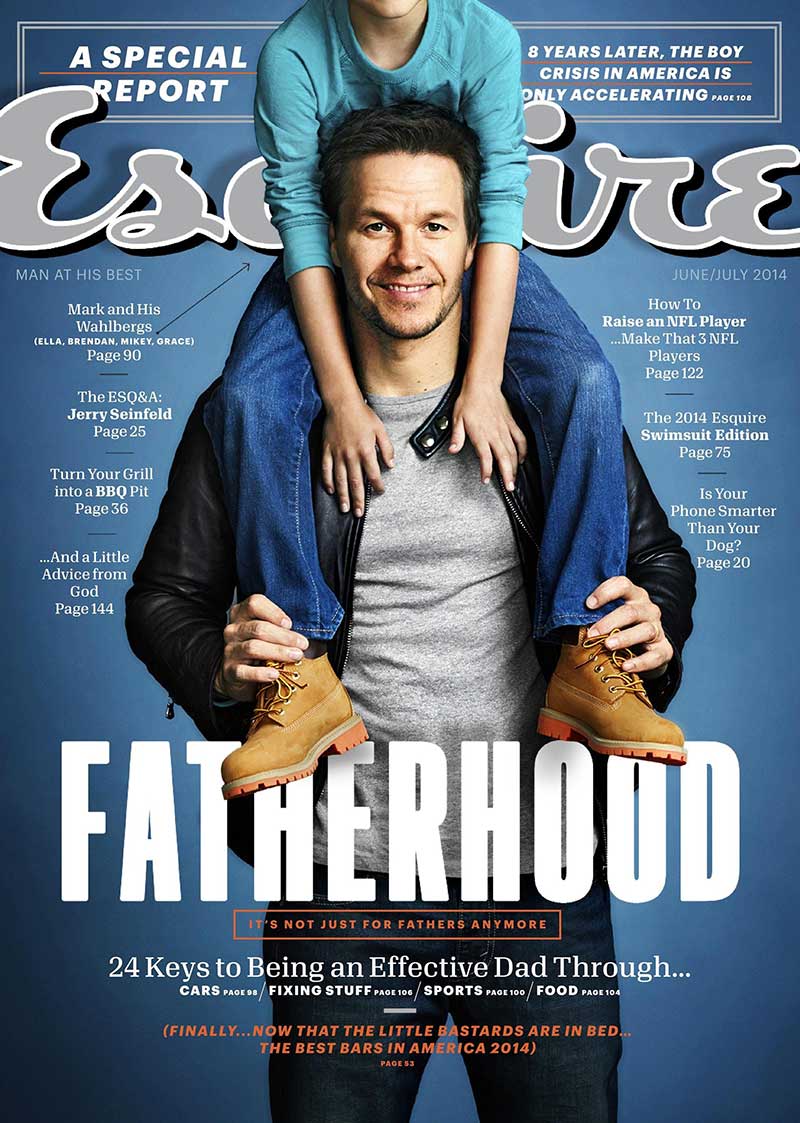Above all, Esquire Editor in Chief David Granger wants to bring his readers to tears. As the longest-serving editor of America’s oldest men’s magazine, Granger, who exits this week, restored Esquire’s relevance by embracing the emotional depth of men’s interests. Cars, sports, sex, and suits have their place, but with ambitious reporting and inventive storytelling, Granger has sought to bring readers to their emotional edge, and even to tip them over it. His Esquire succeeded when its manliest reader was compelled to weep.
Great editors embody their brands: Anna Wintour of Vogue, David Remnick of The New Yorker, Graydon Carter of Vanity Fair. Granger, who at 59 belongs to their generation, has used Esquire to stretch the bounds of conventional masculinity even as the culture was forcing us to re-imagine what it means to be a man. He is conservatively stylish, married with twin daughters in their 20s, exceptional at golf and tennis, a wordsmith and frequent F-bomber, impatient, competitive, fond of tequila and novels (including the “American tough guy” genre), gentle, reticent, and beloved by his staff. After 19 years and 234 issues spanning an era of editorial and financial resurgence for the once-comatose monthly, he and Esquire have become inextricably intertwined.
But that model is showing signs of strain. Since Granger has been at the helm of Esquire, corporate bosses have grown less comfortable with headstrong editors. Even the most accomplished print magazines now depend on other platforms, and Esquire’s most vexing problem has been its website, a bizarre amalgam of serious news, pictures of half-naked women, and listicles with clickbait headlines. Many of the magazine’s top-flight writers-at-large have been with Granger at Esquire from the start, fixtures on a masthead that’s been mostly static for a generation.
In January, Granger had long phone conversations with each of those writers. At 9:30 on the last Friday morning of that month, a few-dozen staffers in the Manhattan office were summoned for a meeting with David Carey, president of Hearst magazines. About five minutes before Carey came downstairs, Granger told the assembled staff that he had been fired. Then they waited silently, stunned.
Arriving with Jay Fielden, the 46-year-old editor of Hearst’s Town & Country who will take over Esquire on April 1, Carey praised Granger’s leadership and the magazine’s achievements. Nothing was said to elucidate the bombshell. “There was a real sense of, What the hell is this? Are we getting raises?” one staffer recalled. “It was like a graduation ceremony,” another said.
Three days later, at the National Magazine Awards dinner, the 500-plus editors and publishers on hand gave Granger a standing ovation. Taking the stage to accept his 17th “Ellie” while at Esquire, this one for Essays and Criticism, an emotional Granger said, “I’m so happy about this I’m just going to quit.”
Outlets like The Times reported that Granger is stepping down. He’s not. He was ousted against his wishes, and his top writers and editors don’t know why. Magazine shakeups are notoriously erratic and merciless, but this move has baffled many, especially those who’ve worked loyally with Granger for decades.
Carey has declined to explain his decision. Since he left Condé Nast in 2010 to oversee Hearst’s 21 US magazines, 15 have gotten new editors. Granger signed a severance agreement that prevents him from discussing his firing. Those who know him and the magazine best say the move reflects a broader struggle over Esquire’s identity. The fate of Granger’s seasoned inner-circle—and the slow, expensive journalism they practice—is in question.
Man at His Best, Granger says of the magazine’s slogan, “makes a promise.” Of what, exactly? New leadership signals a new promise, one that Granger was either uncomfortable with or incapable of keeping.
According to No. 617 of Esquire’s Rules for Men, “You don’t start understanding life well until you’re forty.” Granger was 40 when he became editor of Esquire—and 22 when he began gunning for that job. There was never a moment in between when he would’ve been content as a permanent subordinate.
He was a senior at the University of Tennessee in 1979 when two recent Tennessee alums bought Esquire and changed its slogan to Man at His Best from The Magazine for Men. Esquire had emerged at the height of the Depression seeking to be “the common denominator of masculine interests” at a time when magazine advertisers targeted women. Writers like F. Scott Fitzgerald, John Steinbeck, Norman Mailer, Tom Wolfe, Philip Roth, James Baldwin, Joan Didion, and Nora Ephron established Esquire’s cachet. Pin-up models, especially during World War II, broadened its popularity. In 1953, Hugh Hefner, a former Esquire copywriter, created Playboy, and in 1980 Condé Nast bought GQ from Esquire, Inc. Around 1986, when the Tennessee alumni sold the magazine to Hearst, Esquire began to lose its luster.
After college, Granger earned a master’s in English from the University of Virginia, then tended bar for a year in Chicago to be with his future wife. He moved to New York in 1982. His first media job was at Muppet Magazine, writing a column about children’s books on behalf of Rowlf the Dog. After a year, he told his boss he didn’t care for his additional administrative duties, and was fired.
While briefly at SPORT magazine, Granger saw a photo of himself interviewing Cincinnati Reds MVP Dave Parker. Parker was in uniform, and, as Granger remembers, “I’m in some terrible blue chinos, this awful blue and white checked shirt, my hair was a mess, and I had some horrible mustache.”
“Looking at that picture, I decided I was not going to be badly dressed.”
Granger has used Esquire to stretch the bounds of conventional masculinity even as the culture was forcing us to re-imagine what it means to be a man.
John A. Walsh hired Granger as a research assistant for a book on football’s Heisman trophy. Walsh would become a hugely influential executive editor at ESPN, and in 1989 he recommended Granger for features editor of The National, a daily sports startup that flopped after a year. But word of Granger’s talent there reached GQ’s brash editor in chief, Art Cooper, who hired Granger in 1991.
On his first day, with nobody there and nothing to do, Granger skimmed through a file of nixed articles and was struck by a piece about oysters by an unknown reporter named Tom Junod. He phoned the Atlanta-based writer and said, “I really like the piece. It’s the voice I want to build a magazine around.”
Immediately, Granger began refining his approach to magazine articles and recruiting a stable of writers who could execute it. He wanted journalism to read like fiction. He admired guys with big personalities who’d gone to state colleges, held odd jobs, and lived outside New York. “I’ve always wanted my writers to be absolutely responsible when it comes to reporting and accuracy,” Granger says, “and, on the other hand, completely irresponsible when it comes to use of the English language.”
One writer, Mike Sager, had spent two years trying to convince Art Cooper to let him do “an anthropological profile of a fat guy”—not an obvious fit for GQ. Granger convinced Cooper to run it. So began two decades of Granger assigning oddball profiles to Sager: a teenager, an ugly guy, a 90-year-old, a beautiful woman. It required unusual faith in the writer, and the reader.
In 1996, Granger tried his hand at writing but found it too strenuous. “I learned a long time ago I wouldn’t hire me as a writer,” he now says. He wrote a cover story on Andre Agassi, the tennis superstar known for his shoulder-length hair. For the piece, Granger and Agassi went to a barbershop and had their heads shaved. Both made the look permanent.
By the mid-1990s, Men’s Health and Details were fracturing men’s magazine readership at a time when, The New York Times observed, “most magazines are struggling for new ways to remain vibrant in the face of interactive media, CD-ROMs and the charms of cyberspace.”
Granger climbed to third in command at GQ, but with his boss firmly planted at the top, he began angling for a move. His assistant at the time, Adrienne Miller, says the first thing he would grab in the mail each month was the ever-thinner copy of Esquire. A 1996 Times headline asked, “Has Esquire Gone Out of Style?” The January 1997 issue sold just 13 pages of ads. Circulation was plummeting. Granger wrote a letter to David Carey’s predecessor at Hearst, Catherine Black, outlining a vision to revive Esquire.
“It had lost touch,” says Peter Griffin, then an editor at Time Inc., who joined Granger early at Esquire. “It was still catering to a New York-centric, vaguely literary-slash-celebrity sense of the world that had ceased to exist.”
A year after rebuffing Granger, Black gave him the job. By then, Granger’s writers were industry phenoms. Having immediately fired much of the Esquire staff, Granger leaned hard on them. Granger “begins work today on the Sisyphean task of restoring Esquire’s prestige,” The Times observed in June 1997.
Though probably unsurprised, Cooper was incensed. Around GQ, word was that “the poets have left the building.” The Esquire–GQ rivalry intensified.
Cooper, who died in 2003 at 65, was a “magnificent bastard,” recalls Scott Omelianuk, an editor at GQ before leaving with Granger to be his No. 2 at Esquire. Another defecting editor, Lisa Hintelmann, remembers pictures of nude models hanging on the wall behind Cooper’s desk. Granger says the boss, who took daily lunches at the Four Seasons, taught him to be “larger-than-life as an editor, but I also learned what not to do. He could be senselessly cruel.” When Junod won his first National Magazine Award, he recalls another writer reaching for the trophy and Cooper saying, “Don’t touch that. Until you win one, you can keep your hands off it.”
Cooper reportedly offered Junod a $300,000 two-year contract to stay, but Junod defected with Granger anyway, explaining that he did so “as a way of refusing Art’s inference that I could be bought. He never understood that—never understood that my loyalty to David ran deeper than my ambitions. Or maybe he did understand it, and that’s why the mass migration of his writers and editors wounded him so.”
Fear of failure has tormented Granger’s sleep for 19 years. He often wakes at 3 thinking, “Fuck, am I fucking this up?” By 6, he’s left his house in Westchester for the hourlong drive to work. Initially, he feared letting his staff down. Later, he worried about the product growing stale.
University of Tennessee senior Peyton Manning appeared on Granger’s first cover at Esquire, under the question, “Does Football Still Matter?” (Spoiler: Yes.) In the second issue, Junod made a rhetorical game of outing Kevin Spacey. “We were trying to shake things up,” Junod says. “It was kind of a disaster.”
Granger had never managed a newsroom, but he understood the constraints of rigid hierarchy. “He came in and democratized the place,” says Executive Editor Mark Warren, who worked for the previous three editors in chief. “He insisted on integration of the junior staff.”
About a week into the job, Granger leaned over the cubicle wall of a 25-year-old editorial assistant named Andy Ward and asked, “Who should be writing for this magazine?” Ward suggested David Sedaris, whose novel Naked he’d been reading. Granger said to call him. A month later, Ward had assigned Sedaris a feature.
Now the editor in chief of Penguin Random House, Ward says, “David showed me how to care. He cared so much about every sentence.” The boss was never gushing, though. “You’d work for three or four months on a story, it would ship out, and you’d get an email from David and all it said was, ‘I’m fucking proud to publish that piece.’ Because he was so judicious with his praise, it really meant something when you got that.”
For the February 1998 cover, Junod profiled Mister Rogers, the children’s TV host, then 69. Granger and his staff adored the piece, but on newsstands it was a disaster—the worst-selling issue of Granger’s career. When Valerie Salembier, who was publisher of Esquire from 1996 to 2003, recently thought back on that cover, she could only smile and shake her head.
After the Mister Rogers flap, Granger took covers for the commercial bait-and-switch they are: In the last 19 years, Esquire’s have mostly featured middle-aged actresses in underwear or middle-aged actors in suits. About 90 percent of celebrities pictured were white. For the May 2008 cover, Jessica Simpson was shown shaving, à la the Italian actress Virna Lisi on an iconic 1965 issue. The text around Simpson read, “We shot this image to catch your eye so you will pick up this issue … and immerse yourself in the most gripping story you will read this year.” That story, on the transport of a military corpse to burial, won the National Magazine Award for Feature Writing.
The invasion of British “lad books”—Maxim, Penthouse, FHM—drew American men toward the lewd and lowbrow. “What does it have to do with me?” Granger asked The New York Observer in 1999 when questioned about the threat of Maxim. When editors proposed reinstating the “Sexiest Woman Alive” special issue, Granger initially balked. But over time he’s come to terms with risqué photography. “It’s always been difficult to walk the fine line between totally objectifying a gender and serving a keen interest that I know my readers have,” he says. “Every time we do any kind of reader research, it’s, We’d like more women, please.”
When contributing editor AJ Jacobs asked about photo plans for a piece on Mary-Louise Parker, Granger said to get a “tasteful nude” (no exposed private parts, black and white). Parker agreed only if Jacobs were photographed naked, too. He was, and the photos ran in the magazine with an essay, which begins, “I’d always dreamed of a movie star asking me to get naked, but this isn’t exactly what I’d had in mind.”
Lisa Hintelmann, who booked celebrities for four years with Granger at GQ and his full run at Esquire, says, “I’d be lying if I said it’s easy to be a woman at a men’s magazine when it comes to this domain.” But she’s been a voice of restraint against over-sexualizing women, at least where possible.
Driving to play tennis one weekend in 1999, a friend asked Granger, “How come there’s no Martha Stewart Living for men?” On Monday, he called a staff meeting. “We need to adopt this feeling Martha gives off, that I love you, I love your life, and if you trust me, I’ll make your life better,” Granger recalls saying. “I think that’s when we started doing a lot of really good packages and stories that tried to help men live better lives.” That recalibration bolstered fashion coverage, a boon for advertising. Esquire was losing around $15 million annually when Granger took over; by the early 2000s it was profitable for the first time in years.
Over and over, those who’ve worked with Granger stress his sense of loyalty. Loyalty empowers reporters to break from convention, the signature quality of journalism under Granger. “David has always wanted to give his writers a long leash. That’s great sometimes, and sometimes it doesn’t work out,” says Scott Omelianuk, who left Esquire in 2003.
The day after Jim Nelson became editor in chief of GQ, in 2003, Andy Ward, who’d been elevated to articles editor at Esquire, took a job there. He calls it one of the most painful moments of his career. When he went into Granger’s office to tell him the decision, “He was not happy at all. He said to me, ‘I understand that you need to do this, and that’s OK. But we’re not going to talk for a long time.’ ” They went out that night and got hammered. Ward says he didn’t hear from Granger for several years after that.
Granger says he doesn’t remember that part. They’re now on good terms.
Another falling out is probably permanent. In his book How To Get Rich, Donald Trump chronicles a random week in 2003. Tuesday at 9:15 am: He’s planning a Friday foursome at Trump National Golf Club in Westchester that will include Bill Clinton. “Joining us will also be David Granger, the editor in chief of Esquire, a dapper guy on and off the golf course.”
Granger and Trump had met earlier that year, when Esquire converted a penthouse at Trump World Tower into a fantasy bachelor pad as a way to pair advertisers with wealthy partygoers. The next year, after the first season of The Apprentice, Trump made the cover of Esquire, with the caption, “How I’d Run the Country (Better).” This January, the GOP presidential frontrunner returned to the cover, along with the words “HATER IN CHIEF.” A publicist called Granger to say that Trump felt betrayed.
In 2003, Andy Langer, Esquire’s new music critic, went to Cupertino, California, for the rollout of iTunes and a rare sit-down with Steve Jobs. Four pages in the magazine were held past deadline for the exclusive. Midway through the interview, perhaps unnerved by Langer’s skepticism about record label cooperation, Jobs abruptly stepped out, and Apple staff told Langer to leave. The head of Apple marketing called Granger and said the interview was retracted. If Esquire didn’t cooperate, Apple would cease advertising in the magazine. Granger refused, and for many years Apple kept its word.
Granger’s Esquire won its sole National Magazine Award for General Excellence in 2006. But with the magazine facing digital tumult, it was hardly a chance to sleep easy.
Exasperated by a chorus of experts predicting the death of print, Granger became dedicated to disproving them. “Print magazines are the most exciting medium ever created,” he’d say repeatedly. But while some magazines have embraced the digital transition, Esquire‘s website is bewilderingly disconnected from its print product. Asked if there’s a rift between editorial standards in print and online, one print editor just laughed and said, “Uh, yeah.”
The print edition is a delicate balance of high- and lowbrow, light fare and rigorous journalism. Esquire.com skews toward the superficial. If “The Women We Love” in the magazine is a tenuous ode to beauty and elegance, “The Women We Love on Instagram” is essentially a poor man’s porn.
Granger lost control of the website about a year ago, and although he has met frequently with the Web team and insisted that they share the newsroom, esquire.com has degraded quality control. It reflects a factory-like editorial mindset—what about the Esquire mission supports publishing a slideshow of 50 famous photos with wire-service captions one Monday morning?
Having vowed to optimize print, meanwhile, Esquire created covers with folding photos, a short story that ran in the margins along 102 pages (wrote one offended reader: “You’ve marginalized fiction”), and a cover with “augmented reality” animation when held up to a webcam.
“Oh, I love gimmicks!” Granger says. “If my perfect magazine story was expressed as a movie, it would’ve been The Big Short. That movie was all about the gimmicks,” like a cutaway to Margot Robbie in a bubble bath explaining subprime mortgage loans.
For 2008, Esquire spent more than a year on what Granger calls “the hardest thing we ever did,” a so-called e-ink cover for the 75th anniversary issue. Mini batteries were installed with enough juice to flash “The 21st century begins now” on the cover for 90 days. The special edition was only distributed on newsstands: 100,000 copies, each with a production cost of $12. But Ford Motor Company, with its own e-ink ad inside, footed the $1.2 million bill. “It was magic!” Granger says of the finished product. Some media critics were intrigued. Others called it an empty stunt.
When the recession hit, Granger had to fire 20 percent of his staff. David Carr, the late Times media columnist who championed the enduring value of print and the need for digital adaptation, hailed Granger for navigating those “dark days.” In early 2010, Esquire’s ad pages ticked upward while men’s magazines’ collectively lost 16 percent. Throughout Granger’s tenure, total circulation has sat around 700,000, while GQ’s exceeds 900,000.
In 2013, Hearst formed a strategic partnership with NBCUniversal to rebrand the entertainment channel G4 into the Esquire Network. Driven by syndicated reruns like Parks and Recreation and carryover G4 programming like American Ninja Warrior, the Esquire Network is slowly adding shows that reflect the magazine, like Best Bars in America, but there’s little resembling serious journalism.
At David Carey’s urging, Network President Adam Stotsky met with Granger on a monthly basis. “He represents the heart and soul and certainly the vision of the Esquire brand,” Stotsky says of Granger. Many presumed that wasn’t expendable.
At 55, Tom Chiarella is one of Esquire’s younger writers-at-large. He’s lived in Indiana for his 18 years at the magazine, but calls Granger “just about my best friend.” “Part of why I can write about what it means to be a man,” Chiarella says, “is because he’s what I’d want to be as a man.”
They talk on the phone most days. A couple years ago, Chiarella mentioned that he was writing a eulogy for a friend, and Granger nagged him for over a year to write about it. He finally did. Recently, he told Granger that he’s bored having lived in the Midwest for so long. That’s an essay in Granger’s final issue.
“Some part of the magazine is in service to the readers,” Chiarella says, “not really to teach, but to offer knowledge that comes in adulthood.”
The magazine’s perspective has certainly matured, and its editors and writers seem to have embraced that. Some lifelong curiosities, however, don’t go over as they once did. In August 2014, Granger thought it noteworthy that “icons of female beauty and the essence of femininity were all women in their early middle age.” He asked Junod to write about it, which he did one afternoon. It ran as a two-page spread in print, “In Praise of 42.”
“It aroused a furor unlike anything I’ve experienced,” Junod says of the online reaction. “I’ve written much chancier and riskier things, but the environment has changed with social media being the judge, jury, and executioner.” A headline on Talking Points Memo asked, “Esquire Writer Lusts After 42-Year-Old Women: Is this Progress?
So-called men’s bibles are not timeless; their value—to readers and advertisers—is in being attuned to culture. Maxim and Penthouse are in decline, and the fashion-oriented, safe-for-work Details was shuttered last year. Beginning this month, Playboy will no longer feature full nudity in the magazine. Granger was never beholden to tradition, though. When he was hired, he thought the magazine was coasting on past glories and a dated formula. His instinct was to innovate, almost compulsively.
But as Esquire’s 1,000th issue approached, that changed. “I’ve been thinking about the fact that we live in a time in which the past has never been more present,” he wrote for that commemorative issue, last October. That month, the magazine unveiled Esquire Classic, a collection of every issue since September 1933. “Esquire is at its best and most successful when it starts over,” he added in that letter, “when it is reimagined by the people who make it in order to better address the lives of its readers.”
That was several months before Granger learned he’d been fired. Apparently, Carey believes one person can only reimagine so much. Or perhaps he just wanted his own guy in charge; Fielden edited Men’s Vogue when Carey was at Condé Nast. Any explanation is speculative.
“I think Hearst made a terrible mistake,” Valerie Salembier says. “Shame on them. Ageism, I would call it.”
Granger shook his head at that notion, and won’t acknowledge bitterness about his departure. He hasn’t considered what he’ll do at the end of the month, when he closes the May issue, his last.
Sometime since Esquire became the first American men’s magazine, in 1933, celebrating manhood has fallen out of fashion. Ernest Hemingway reported from Cuba in the first issue; the 1,000th issue, last October, featured a takedown of the swaggering writer’s hollow machismo. One of Esquire’s famed reporters of the ’60s, Gay Talese, fretted to The New York Times in 1993, “Where is the place for a male magazine when being male is almost held against you?”
Granger and his team, initially a “testosterone-fueled” bunch, as several writers put it, had a remarkable run becoming men together. There was no Esquire male ideal that Granger pushed on his staff, other than to let emotion drive their work.
Ten years ago, Junod and Mark Warren, the executive editor, traveled to Mississippi in search of someone affected by both the Iraq War and Hurricane Katrina. They found Stephanie Lee, a 28-year-old recent war widow who gave birth to her second daughter three days after the storm hit. Eight years after that profile ran, Lee contacted Warren to say she’d been diagnosed with terminal colon cancer. They connected her with doctors developing cutting-edge “personalized medicine,” and she became one of its first subjects.
“David has a peerless story sense. He understood that that was going to be a portal,” Warren says. “But there’s also something deeply human about David that just got to him about Stephanie,” who died in February 2015.
In the final story about her, published in August last year, Junod described how Warren became the caregiver for Lee and her children when they had nobody else. That’s not standard practice for journalists, but this was an exceptional case that, as Granger urged, merited exceptional devotion.
He can’t read that passage about his colleague’s commitment without tearing up. What do you even call that sort of effort from your staff? Maybe Man at His Best.
Danny Funt is a senior editor at The Week and a former CJR Delacorte Fellow. Follow him on Twitter at @dannyfunt

